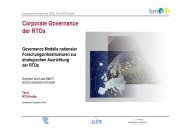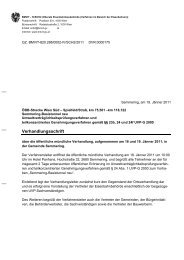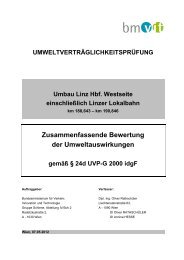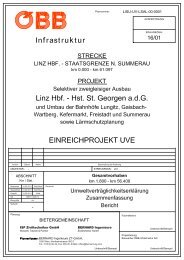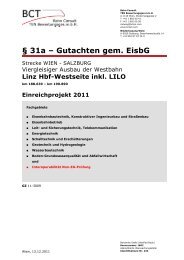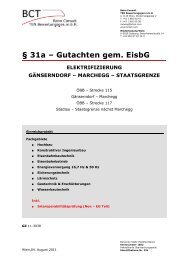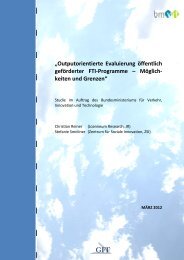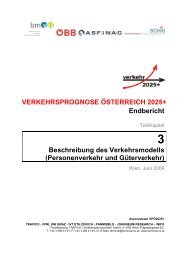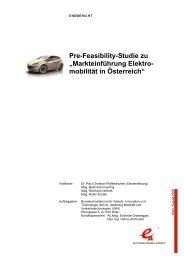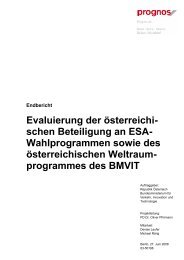Schriftenreihe .;technologiekompetenz Verkehr in
Schriftenreihe .;technologiekompetenz Verkehr in
Schriftenreihe .;technologiekompetenz Verkehr in
You also want an ePaper? Increase the reach of your titles
YUMPU automatically turns print PDFs into web optimized ePapers that Google loves.
The substitution of fossil fuels by biofuels <strong>in</strong> the ICE of the HEV<br />
or <strong>in</strong> power plants might offer additional benefits <strong>in</strong> terms of<br />
GHG emissions and energy security. The European Union has<br />
therefore set mandatory targets for biofuel substitution for 2010<br />
and beyond. Concerns about ris<strong>in</strong>g food prices and endanger<strong>in</strong>g<br />
biodiversity by convert<strong>in</strong>g land to biofuel production, as well as<br />
uncerta<strong>in</strong>ties over CO 2 reduction values, have led to calls for the<br />
reduction or outright rejection of these targets. Regard<strong>in</strong>g the<br />
latest announcements of the European Parliament and the<br />
European Commission and proposals concern<strong>in</strong>g the promotion<br />
of renewable energy <strong>in</strong> the European Union, electric mobility<br />
seems to play an <strong>in</strong>creas<strong>in</strong>gly important part <strong>in</strong> future scenarios<br />
as discussions on derat<strong>in</strong>g targets for biofuels are under way,<br />
favour<strong>in</strong>g cars runn<strong>in</strong>g on green electricity and hydrogen.<br />
Another remarkable issue concerns the scope of the renewable<br />
directive, now widen<strong>in</strong>g up from road to all modes of transport<br />
<strong>in</strong>corporat<strong>in</strong>g tra<strong>in</strong>, air and maritime where fossil fuels are<br />
utilised. This latest political development further tends to<br />
stimulate market penetration of hybrid and electric vehicles and,<br />
furthermore, opens new markets for R&D projects <strong>in</strong>volv<strong>in</strong>g<br />
modes of transport other than road.<br />
The limited range of EVs is generally seen as the ma<strong>in</strong> drawback<br />
for their market <strong>in</strong>troduction. Although statistical evidence<br />
shows clearly that already exist<strong>in</strong>g battery technologies cover<br />
the overwhelm<strong>in</strong>g majority of daily trips, the psychological<br />
reluctance of vehicle users to use an EV for fear of gett<strong>in</strong>g stuck<br />
on the road if they need to travel further has to be taken<br />
seriously. Most OEMs therefore foresee a split of the vehicle<br />
market <strong>in</strong>to segments optimised to specific applications. HEVs<br />
us<strong>in</strong>g ICE or fuel cells offer clear advantages <strong>in</strong> range. But the<br />
extraord<strong>in</strong>ary expense for the need of several cars is a major<br />
economic barrier for their market <strong>in</strong>troduction.<br />
At this po<strong>in</strong>t transport policy comes <strong>in</strong>to play fac<strong>in</strong>g the problem<br />
that citizens are under economic pressure to use the car as<br />
often as possible as soon as they acquire a vehicle. The high<br />
<strong>in</strong>vestment costs of buy<strong>in</strong>g a vehicle and its quick devaluation<br />
with<strong>in</strong> a couple of years make it hardly attractive to switch<br />
between different transport modes and choose better or more<br />
susta<strong>in</strong>able transport means. Models separat<strong>in</strong>g the use of a<br />
vehicle from ownership like car-shar<strong>in</strong>g and car-pool<strong>in</strong>g or<br />
leas<strong>in</strong>g models for the whole car similar to those for the battery<br />
as described above might be a solution for us<strong>in</strong>g the optimal<br />
vehicle or transport mode for each trip.<br />
For the eco-balance it is necessary to consider the end of<br />
lifetime of the battery systems as well. Recycl<strong>in</strong>g processes for<br />
current battery systems either depend on metal recovery for<br />
economic feasibility (e.g. nickel, cobalt) and/or on regulatory<br />
framework conditions reduc<strong>in</strong>g the environmental impact (e.g.<br />
lead). Future automotive batteries are likely to use little or no<br />
nickel/cobalt and very small amounts of precious metals if any at<br />
all. Purity requirements for materials used <strong>in</strong> batteries are<br />
generally very high. Therefore, new and improved recycl<strong>in</strong>g<br />
processes need to be developed for new cell chemistries <strong>in</strong><br />
CONCLUSION<br />
order to recover as many materials as economically possible.<br />
As recycl<strong>in</strong>g generally has lower environmental impacts than<br />
primary production it should be taken <strong>in</strong>to account <strong>in</strong> the<br />
development of new cell chemistries and for the design of the<br />
next-generation battery systems. Future battery chemistry with<br />
higher energy and power density, extended lifetime and<br />
reasonable costs needs to offer possibilities for recycl<strong>in</strong>g at<br />
adequate costs.<br />
Summ<strong>in</strong>g up the state of vehicle technology one can say that<br />
hybrid technology is available on the mass market today.<br />
Generally technology for electric vehicles fulfill<strong>in</strong>g the needs of<br />
daily transport with<strong>in</strong> a range of up to 50 km is available <strong>in</strong><br />
pr<strong>in</strong>ciple but not on the mass market. Besides the requirements<br />
regard<strong>in</strong>g energy and power density, the price of the energy<br />
storage systems, as well as safety issues and efficient power<br />
electronics seem the ma<strong>in</strong> hurdles to be overcome for a<br />
successful pure battery electric vehicle on the mass market.<br />
As mentioned before, power electronics play a key role <strong>in</strong> the<br />
future of hybrid and electric vehicles. The automotive power<br />
electronics market has been grow<strong>in</strong>g significantly over the last<br />
years, even at a higher rate than the vehicle market. The ma<strong>in</strong><br />
area of application for microelectronics is the drive tra<strong>in</strong>. Recent<br />
studies showed that a shift of the OEM’s value cha<strong>in</strong> from the<br />
drive tra<strong>in</strong> to power electronics is already visible. The turnover of<br />
electronic parts <strong>in</strong> the automotive sector is roughly estimated at<br />
10 billion US$ for Europe alone <strong>in</strong> 2009. At present, suppliers<br />
are strongly <strong>in</strong>vestigat<strong>in</strong>g cost effective, compact, durable safe<br />
and highly <strong>in</strong>tegrated systems. Unlike other areas of application,<br />
power electronics for hybrid and electric vehicles require a close<br />
<strong>in</strong>terl<strong>in</strong>k<strong>in</strong>g of the subsystems (control and power electronics,<br />
electric drive and the ICE). The challenge is to develop a<br />
compact system with an efficient thermal management, high<br />
reliability and lifetime at moderate cost. Therefore a close<br />
cooperation of all stakeholders on the standardization of<br />
components will be necessary <strong>in</strong> order to br<strong>in</strong>g costs down.<br />
The <strong>in</strong>troduction of hybrid systems offers new chances for the<br />
automotive supply <strong>in</strong>dustry. The value cha<strong>in</strong> of future vehicles<br />
will be different to conventional ICE vehicles as the energy<br />
storage system and power electronics have a valuable share of<br />
costs. This circumstance may also offer a chance for smaller<br />
automotive suppliers. The progress of R&D and the strong<br />
<strong>in</strong>terest of car manufacturers <strong>in</strong> the electric drivetra<strong>in</strong> give a<br />
positive perspective on the future of electric drivetra<strong>in</strong>s used for<br />
HEVs and EVs.<br />
Austria has many competent <strong>in</strong>dustrial companies and research<br />
<strong>in</strong>stitutions work<strong>in</strong>g <strong>in</strong> the field of hybrid and electric vehicles,<br />
energy storage technologies and electronic control systems.<br />
The BMVIT has been fund<strong>in</strong>g their R&D activities through<br />
research promotion programmes and centres of competence for<br />
many years. The follow<strong>in</strong>g chapters describe the high expertise<br />
of these <strong>in</strong>dustrial and research partners <strong>in</strong> the product Know<br />
How and eng<strong>in</strong>eer<strong>in</strong>g of the electric drivetra<strong>in</strong>.<br />
39




